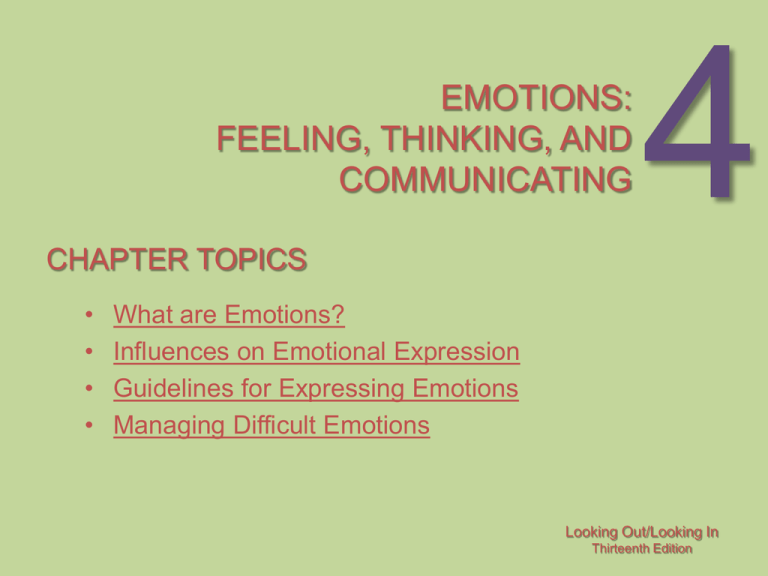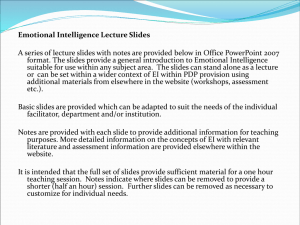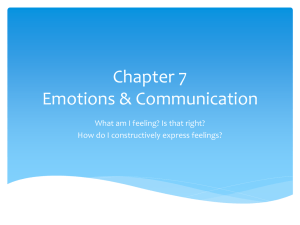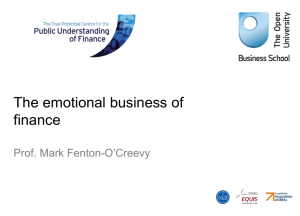
EMOTIONS:
FEELING, THINKING, AND
COMMUNICATING
4
CHAPTER TOPICS
•
•
•
•
What are Emotions?
Influences on Emotional Expression
Guidelines for Expressing Emotions
Managing Difficult Emotions
Looking Out/Looking In
Thirteenth Edition
What Are Emotions?
• Physiological Factors
• Strong emotions are coupled with strong
physiological factors
• Physical components of fear:
•
•
•
•
•
Increased heart rate
Rise in blood pressure
Increase in adrenaline secretions
Elevated blood sugar
A slowing of the digestive system
EMOTIONS: FEELING, THINKING, AND COMMUNICATING
2
What are Emotions?
• Nonverbal Reactions
• Feelings are often apparent by observable
reactions
• Appearance Changes
• Blushing, sweating, etc
• Behavioral Changes
•
•
•
•
Facial expression
Posture
Gestures
Different vocal tone or rate
EMOTIONS: FEELING, THINKING, AND COMMUNICATING
3
What are Emotions?
• Cognitive Interpretations
• The mind plays an important role in
determining emotional states
• The symptoms of fear discussed earlier are similar
to those of excitement, joy and other emotions
• If you were to monitor someone having a strong
emotional reaction, you would have a hard time
ascertaining which emotion the person was
experiencing
EMOTIONS: FEELING, THINKING, AND COMMUNICATING
4
What are Emotions?
• Verbal Expression
• Words can be required to discover the depth
or intensity of the emotion
• At times we can’t rely on perceptiveness to be
sure a message is communicated
• Is a new acquaintance mistaking your
friendlessness as a come-on?
• Is a lover’s unenthusiastic response a sign of
boredom with you, or something less personal?
EMOTIONS: FEELING, THINKING, AND COMMUNICATING
5
Influences on Emotional
Expression
• Personality
• There is a clear relationship between
personality and the way we experience and
express emotions
• Extroverts tend to report more positive emotions
• Neurotic individuals tend to report more negative
emotions
• Personality doesn’t have to govern your
communication satisfaction
EMOTIONS: FEELING, THINKING, AND COMMUNICATING
6
Influences on Emotional
Expression
• Culture
• A significant factor that influences emotional
expression in different cultures is whether that
culture is:
• Individualistic (United States and Canada)
• These cultures feel comfortable revealing their emotions
to people with whom they are close
• Collectivistic (Japan and India)
• These cultures prize harmony and discourage
expressions of negative emotions which may upset
relationships
EMOTIONS: FEELING, THINKING, AND COMMUNICATING
7
Influences on Emotional
Expression
• Gender
• Biological sex is the best predictor of the
ability to detect/interpret emotional expression
• Research suggests that there is some truth to the
unexpressive male
• In one study, females were 10-15% more accurate
in remembering emotional images
• People in close relationships are likely to
experience/express more emotions than
those who are not
EMOTIONS: FEELING, THINKING, AND COMMUNICATING
8
Influences on Emotional
Expression
• Social Conventions
• The unwritten rules of communication
discourage the direct expression of emotion
• How many genuine emotional expressions do you
or we see in daily life?
• Social rules even discourage too much expression
of positive feelings
• Emotion Labor
• Managing or even suppressing emotions is both
appropriate and necessary
EMOTIONS: FEELING, THINKING, AND COMMUNICATING
9
Influences on Emotional
Expression
• Fear of Self-Disclosure
• In a society that discourages the expression
of emotions, revealing them can seem risky
• Emotional Contagion
• The process by which emotions are
transferred from one person to another
• Is it possible to catch someone’s mood?
• Emotions become more infectious with prolonged
contact
EMOTIONS: FEELING, THINKING, AND COMMUNICATING
10
Guidelines for Expressing
Emotion
• There is not a universal rule for expression
of emotion
• Personality, culture, gender, play a part
• The key is to express emotion constructively
• Think about a time when you expressed your
emotion clearly, then wish you hadn’t.
• Those who control their feelings and deny
distress are more likely to get a host of
ailments, including cancer and heart disease
EMOTIONS: FEELING, THINKING, AND COMMUNICATING
11
Guidelines for Expressing
Emotion
• Recognize Your Feelings
• Beyond being aware, also try to identify
• Recognize the difference between feeling,
talking and acting
• Expand your emotional vocabulary
• Share multiple feelings
• You might often express anger but overlook
confusion, disappointment or frustration
EMOTIONS: FEELING, THINKING, AND COMMUNICATING
12
Guidelines for Expressing
Emotion
• Consider When and Where to Express
Your Feelings
• Give yourself time to discover the gravity of
the emotion before full expression
• Accept responsibility for your feelings
• Instead of saying:
• “You’re making me angry!” try “I’m getting angry.”
• “You hurt my feelings,” say “I feel hurt when you do
that.”
EMOTIONS: FEELING, THINKING, AND COMMUNICATING
13
Guidelines for Expressing
Emotion
• Be Mindful of the Communication Channel
• Mediated Channels
• Email
• Instant Message
• SMS Message
• Is it appropriate to end a relationship via
voicemail?
• What is the result of using CAPITAL
LETTERS in an instant message or email?
EMOTIONS: FEELING, THINKING, AND COMMUNICATING
14
Managing Difficult Emotions
• Facilitative and Debilitative Emotions
• Facilitative Emotions
• Are emotions which contribute to effective
functioning
• Debilitative Emotions
• Are emotions which detract from effective
functioning
• Intensity
• Anger or irritation may be beneficial
• Rage usually makes matters worse
EMOTIONS: FEELING, THINKING, AND COMMUNICATING
15
Managing Difficult Emotions
• Sources of Debilitative Emotions
• Our genetic makeup
• Emotional memory
• Harmless events can trigger debilitative feelings
• Self-talk
EMOTIONS: FEELING, THINKING, AND COMMUNICATING
16
Managing Difficult Emotions
• Self-Talk
• Interpretations people make of an event,
during the process of self-talk that determine
their feelings
Event
Thought
Feeling
Being called names
“I’ve done something wrong.”
hurt, upset
Being called names
“My friend must be sick.”
concern,
sympathy
EMOTIONS: FEELING, THINKING, AND COMMUNICATING
17
Managing Difficult Emotions
• Irrational Thinking
• The Fallacies
• The Fallacy of Perfection
• The belief that a worthwhile communication should
be able to handle every situation
• The Fallacy of Approval
• That it is vital to gain the approval of virtually every
person
EMOTIONS: FEELING, THINKING, AND COMMUNICATING
18
Managing Difficult Emotions
• Irrational Thinking
• The Fallacy of Shoulds
• The inability to distinguish between what is and
what should be
• The Fallacy of Overgeneralization
• Basing a decision on limited information
• When we exaggerate shortcomings
• The Fallacy of Causation
• The irrational belief that emotions are caused by
others rather than by one’s own self-talk
EMOTIONS: FEELING, THINKING, AND COMMUNICATING
19
Managing Difficult Emotions
• Irrational Thinking
• The Fallacy of Helplessness
• Satisfaction in life is determined by forces beyond
your control
• The Fallacy of Catastrophic Expectations
• The assumption that if something bad can happen,
then it is going to happen
EMOTIONS: FEELING, THINKING, AND COMMUNICATING
20
Managing Difficult Emotions
• Minimizing Debilitative Emotions
•
•
•
•
•
Monitor your emotional reactions
Note the activating event
Record your self-talk
Reappraise your irrational beliefs
Replace self-defeating self-talk with more
constructive thinking
EMOTIONS: FEELING, THINKING, AND COMMUNICATING
21
Chapter Review
•
•
•
•
What are Emotions?
Influences on Emotional Expression
Guidelines for Expressing Emotions
Managing Difficult Emotions
EMOTIONS: FEELING, THINKING, AND COMMUNICATING
22










